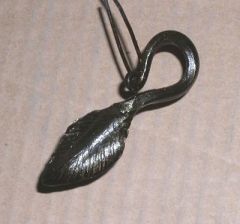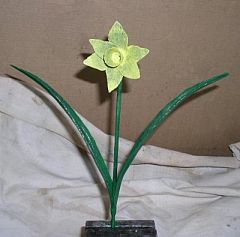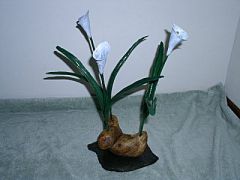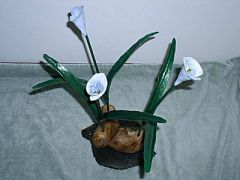
Woody
Members-
Posts
1,015 -
Joined
-
Last visited
Content Type
Profiles
Forums
Articles
Gallery
Downloads
Events
Everything posted by Woody
-
I would imagine that diamond dust in the size of at least 1/4 carat each in the form of ear rings presented to your favorite lady would get you more desirable results than sprinkling it as power on a piece of hot iron. Woody
-
Every time you make a spring, record exactly what you do that way when you finally get the results you want you will be able to easily duplicate it. I would start by heating to critical temperature and quenching in oil, then drawing to a dark blue and work from there. Woody
-
you can draw the temper on the handle portion of the file knife by either imersing the blade up to the handle in water or sticking the blade through a potato up to the handle and then heating the handle with a propane torch until it is dull red and then let it air cool then the handle should be soft enough to drill. Jigging putty will also work in this application. Woody
-
Prohibition of any sort has never worked and never will. We, the U.S., found that out in the 1920s with alcohol. All it does is provide a great source of easy income to anyone willing to violate the law and it does so at the expense and peril of the law abiding citizens. Usually these laws are rammed down the throat of the apathetic majority who oppose them by a very vocal minority who have the ears of the politicians. If the majority is not willing to stand up for what is right and what they believe in, they must be willing to live on their knees at the whim of their masters. Freedom is not free, at times it must be defended on the battlefield with weapons but more often it must be defended in the halls of Congress and/or Parliment with your time and effort. If you do not make your views known to your legislators, you will know what your opponent's views are when they are passed into law. If you are not willing to expend the effort to defend your rights, be prepared to lose them. Woody
-
Bob: get your knives out in front of the public, you may be supprised to see that many people will be willing to fatten your wallet in order to give your knives a new home. Good looking pieces. Woody
-
you should also be aware of the reactions produced when acids contact metals. Hydrogen gas is released and if it collects in an area like an attic or the peak of a roof, it can be ignited with explosive results. Yes you can have a new address with 17 different zip codes. One of the previous posts mentioned that HCL released Chlorine. While Chlorine contains no Oxygen, itis one of the most powerful Oxidizers known. It will cause other materials to ignite and burn furiously. Accodrning to NFPA Manual 491 M "Manual of Hazardous Chemical Reactions" brass burns spontaneously in gaseous Chlorine. Chlorine plus Ammonia evolve Nitrogen Trichloride gas which is not only deadly to breathe, it is extremely explosive. Woody
-
Jeff: Just because the ingredients of a compound do not show up on a MSDS sheet is no reason to assume they are safe. The reason they do not show up is because the formula for the material is propriatary information and the manufacturer don't want his product duplicated by a competetor. The stuff could contain anything including strong acids. You would be well advised to read the sections of the MSDS that contain information on health hazards, first aid and symptoms of esposure. Woody
-
-
Rick: Prayers on the way for you and your aunt Woody
-
Dodge: I have made one set of bbq tools out of 3/8 hex stainless, I twisted it at a yellow heat and it worked fine. I think the stainless I used was 304. Woody
-
Rick: Sorry for not replying sooner, I haven't checked this thread for quite a while, if you will email me I will send you a copy I can't find the blueprint either. Woody
-
Having done and taught Hazardous Material Emergency Response for years, we were always told that the most dangerous container out there was the 55 gallon drum. It can and does contain anything and everything. The labels and markings are usually unreadable or missing and they are usually not cleaned out before they are discarded. They are a bomb waiting for a fuse. Some people recommend filling them with water, but remember that if a flammable residue or vapor is present and you fill the drum with water and leave any air pocket, which is easy to do, you have concentrated the flammable vapor into a smaller area and probably compressed it slightly. Not a good thing if you happen to cut into that pocket with a torch or burn through with an arc welder. Additionally a drum that has been thoroughly washed, rinsed and purged can still explode if an O/A torch is used to cut the drum. You can blow enough unburned gasses from the torch into the container as you are cutting it to form an explosive atmosphere. If you plan on using a used drum for any purpose it is best to wash it out thoroughly and rinse it several times. Then use a drum deheading tool to cut the head out of the drum. The price of the tool is considerably cheaper than a trip to the emergency room or a funeral. Woody
-
IForgeIron Blueprints Copyright 2002 - 2007 IFORGEIRON, All rights reserved BP0266 Building a Chair by Richard Hanson Lay out a full sized diagram of the chair on cardboard. Using a seamstress tape measure I measure the length of the pieces and deduct the necessary amount to allow for drawing out the points. Cut 50 ½ “of 3/16” X 1” flat bar to make the ring for the seat. Bevel ends for good weld penetration. Using ring roller, roll the flat bar into a circle. The inside diameter should be 16” Weld ends of ring together and grind the weld down flush. Put the ring back in the roller and roll it again to even out the welded area. Cut 2 pieces of ½” Round stock 60” long. These will be the base for the seat and the legs. Mark a spot 3” from each end and score with a punch so the marks will be visible on the hot steel. Draw both ends of the rods out from the mark to a length of 6 inches After the ends are drawn to a point, scroll them Cut a ½” section out of the center of one of the rods and chamfer the ends for better weld penetration Cut rods butted to the second rod and position for welding. Tack weld then remove magnets and weld solid Mark a spot on each rod 8” from the center Position ring on marks making sure it is exactly centered Weld ring into place Heat legs and bend 90 degrees Once all legs are bent, check the seat for level and adjust as necessary Cut 2 pieces of ½”round stock 40” long. Mark one end of each bar at 3” from end Draw out to 6” from mark and scroll ends bend other end to a 90 o offset 45 o Position back and weld into place Cut piece of 3/16” X 1” flat bar 18 ¾” long, chamfer ends Roll into a 6” diameter ring weld ends and grind flush Weld ring and re roll to even out welded area Cut 2 pieces of ½” round stock, draw out one end of each to a point and scroll, flatten and bevel the other end for a flush fit to the chair back. Position the scrolls and ring, weld into place Cut 4 pieces of ½” X 1/8” flat bar for the chair leg braces. Drill all in the center for a rivet. Round corners on a belt sander Flatten ends for a fan scroll Roll scroll on the end of the bar All 4 pieces scrolled and ready for riveting The brace riveted and ready for twisting Twist as many times as you want, two twists on each side looks good Weld brace to legs, I picked a spot that was 5 inches from the floor to the center of the brace, but use any distance you want. The chair with the welds ground down, and scale wire brushed off, ready for finishing Mix a Watco Black Walnut Oil with a little gold paint to produce an antique bronze finish, the more gold paint you add the lighter the finish will be. The paint does not mix readily with the oil and will want to settle out and clump in the bottom of the container. It is best to use a shallow container and cut the bristles of your brush short so you can mash the paint and keep it mixed. If you end up with a finish that is lighter than you wanted, simply let it dry then put a coat of plain Watco Oil over it to darken it I used scrap Redwood left over from my deck remodel a couple years ago to make the seat and back. Rip the edges to remove the rounded edge on the boards. Then dowel and glue them together. When the glue is dry sand both sides of the seat with a power sander. Place the board on the metal seat ring and mark the outside circumference cut out seat with a saber saw. Use the belt sander to finish shaping ring and remove saw marks. Then Use a ¼” Round over Bit in the router to round the edge of the seat. Then use a straight cut bit to remove enough stock from the under side so the seat just fits inside the ring. Drill the cross braces under the seat and secure the seat with 4 drywall or deck screws. Drill the seat back ring in 3 places and secure the seat back with 3 long deck screws. Apply a couple coats of Spar Varnish to the seat and back. Sand lightly between coats and if you want rub out the final coat with pumice and oil. The finished chairs and table View full article
-
10"+ exaust pipe. Where do you get it.
Woody replied to Jeff Mack's topic in Blacksmithing, General Discussion
Perhaps check out a fireplace shop or your local HVAC Company. HVAC Compaines usually deal with commercial buildings which require larger pipe and duct work Woody -
if the stainless steel is splitting on you it is an indication that you are working it too cold. Try working it from a yellow heat and stop at an orange color. Woody
-
Very nice Dennis Woody
-
Richard: I would think that the viscosity of the oil would be more of a factor than what type of oil it is. The thinner the oil the quicker it will quench the metal. The more viscous oils like 90 weight gear lube would tend to be a slower quench than say a 10 weight oil. A lot of people swear by ATF which is pure petroleum based oil without a lot of addatives. A lot of people advise that you shy away from motor oils because of the addatives that are in them which can have a toxic effect on the body when vaporized by the hot metal. I use used vegetable oil from a fast food joint because it is free and it works for me. You will have to expiriment a little and see what works for you. Take note of exactly what you do and record the conditions that way when you get the desired result, you can duplicte the process. Woody
-
Never hold a cat and a Dust Buster at the same time
-
I have a 6 gallon can with about 5 gallons of used oil from a fast food restaruant. I have had it for 3 years and it isn't rancid yet. I do my quenching outside and keep the lid handy in case of a fire. I also keep my hands and other body parts off to the side of the can when I am quenching for the same reason. The only drawback I have found from using oil from a seafood place to quench blades is that every time I draw my knife, every cat in the neighborhood shows up. Woody
-
In most of the old time blacksmith shop photos if you look at the anvil or anvils, they are fairly large in size. These old time smiths didn't have money to burn and probably weren't into a Freudian mine is bigger than yours contest mode. They were in business to make money and in doing so used the mose efficient tools available. They would not have purchased a big anvil for the bragging rites. Some seem to be more concerned with the surface damage that might be caused by an errant hammer blow than the internal structural damage that can be done by using a hammer that is too large for the anvil. Like I said I have knowledge of a anvil that weighed in excess of 100 lbs being broke from face to base into 2 pieces by people using a 10 lb sledge to work large pieces of metal on it. This was not a surface ding, the anvil was ruined completely. There is a definate corolation between hammer size and anvil size, it can be exceeded occasionally without harm, but if you pound steel on too small an anvil with too big a hammer too long, you are eventually going to do serious damage to the anvil regardless of how or what the anvil is mounted on even if you never miss the steel and hit the face of the anvil with a hammer.
-
Ed if that theory is correct, then all we need is a slab of tool steel on a secure mount. Not all the energy of the hammer is transferred directly to the mount, it has to pass through the anvil first and if the hammer is too big it will damage the anvil even though it never directly contacts the anvil. I have knowledge of one 150 lb anvil being broke in half by using a 10 lb sledge on it. We gnash our teeth at the thoughts of a chisel being used on the face of the anvil, but then look the other way when a big hammer is used on a small anvil because the damage isn't always immediately apparent. You pound on anything long enough with a big enough hammer and you will break it. Woody
-
From what I have read there is a definate ratio of hammer to anvil size. There was a discussion of this topic on Anvilfire a while back and I think the accepted figure for continuous use was about 50:1 that is 50 lbs of anvil for every 1 lb of hammer. Woody



